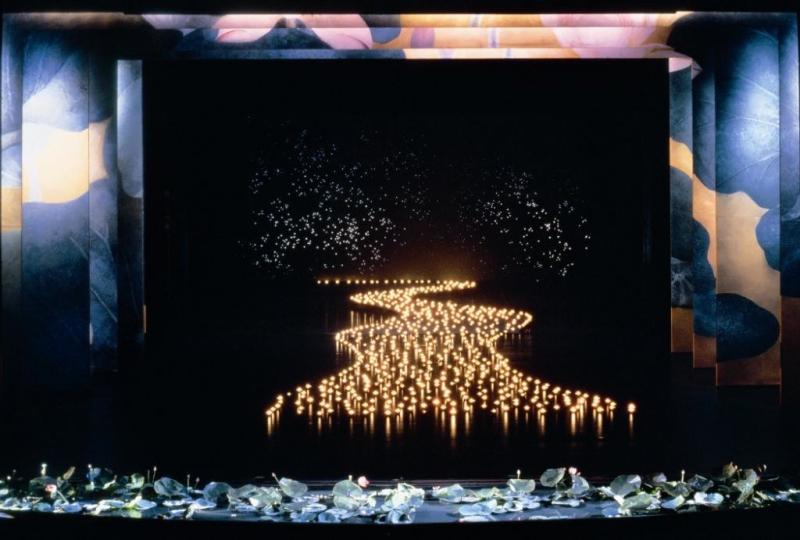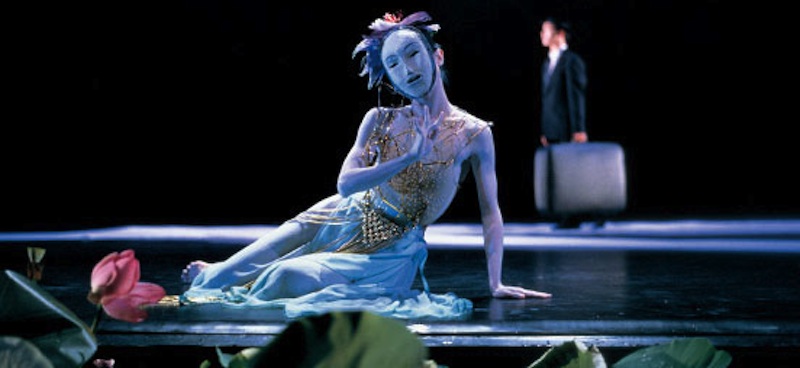Nine Songs, Cloud Gate Dance Theatre of Taiwan, Sadler’s Wells | reviews, news & interviews
Nine Songs, Cloud Gate Dance Theatre of Taiwan, Sadler’s Wells
Nine Songs, Cloud Gate Dance Theatre of Taiwan, Sadler’s Wells
East meets west in this sumptuous revival of a work by Taiwanese choreographer compared with Balanchine

In 2008, a disastrous fire gutted Cloud Gate’s rehearsal studio in Taipei destroying props, costumes and the company archive. Amazingly though, the masks worn by the deities in Nine Songs survived the blaze and Lin Hwai-min, founder of the award-winning company, was so moved by the miracle that he decided to re-stage this sumptuous work.
The phoenix-like revival of the epic, first premiered in 1993, seems especially pertinent since resurrection is a recurring theme. Accordingly, a bed of lotus flowers, symbols of rebirth, fills the orchestra pit and designer Ming Cho Lee has covered the set with huge lotus blossoms enlarged from a painting by Taiwanese artist Lin Yu-San.
All is not a bed of lotuses, though. Nine Songs is based on a cycle of poems by Qu Yuan, doyen of classical Chinese literature, which celebrate life and the seasons but also describe how the vainglorious Gods lead foolish earthlings into debauchery, despair and even death.
A fusion of eastern and western traditions, Lin's choreography is like nothing else
Dressed in a blood-red sheath, a shaman (Huang Pei-hua) dances herself into a frenzy as the circle of white-robed acolytes surrounding her relentlessly beat time with bamboo rods. Later in a stunningly beautiful tableau, the celebrants wave the rods vertically like flickering flames. The Sun God (Yu Chien-hung) appears and, in a lascivious duet with the shaman, asserts his hold over her and the assembled throng.
Losing their moral compass, the acolytes tear off their robes, emblems of spiritual purity, and quickly plunge into cruel depravity. In the most extraordinary sequence of moves I have ever seen, the men manhandle their female partners, shoving, grabbing and shaking them as if they were rag dolls, or holding them aloft in ungainly poses resembling leaping frogs. All end up on the floor, a heaving morass of distressed humanity that reminded me of the damned writhing in agony in Hieronymus Bosch’s painting of The Last Judgement (1482).
A fusion of eastern and western traditions, Lin’s choreography is like nothing else. He studied at the Martha Graham and Merce Cunningham studios in New York before returning to his native Taiwan to set up Cloud Gate in 1973, and his dancers are schooled in contemporary dance as well as in Asian disciplines such as martial arts, Chi Kung, calligraphy and meditation. The resulting banquet is laden with extraordinarily diverse references.
 Dressed in diaphanous white robes, the attendants of the Goddess of the Xiang River (pictured right) are reminiscent of the nubile dancers who skip around the rims of classical Greek pots; while the women bearing candles to commemorate the dead in the closing ritual could have stepped from the walls of some Pharoah’s tomb (main picture, above).
Dressed in diaphanous white robes, the attendants of the Goddess of the Xiang River (pictured right) are reminiscent of the nubile dancers who skip around the rims of classical Greek pots; while the women bearing candles to commemorate the dead in the closing ritual could have stepped from the walls of some Pharoah’s tomb (main picture, above).
One of the most spectacular sequences is performed by the God of Clouds (Chen Wei-an) who, dressed in a g-string and dramatic mask, looks as if he has sprung from the surface of an ancient Chinese vase. “Dancing in the air” (without touching the ground), Chen demonstrates perfect poise as he strikes demonic poses on the backs of two carriers. Representing autumn, the Mountain Spirit (Tsai Ming-yuan) embodies the anguish of the dying year in an angular solo, his mouth held open in a silent scream.
it is hardly surprising that Lin has won a list of accolades as long as your arm
But there’s humour too – in the form of incongruous references to the present. Gliding round the stage beneath the gesticulating God of Clouds, a man on roller skates trails a large flag. Bike riders weave their way back and forth among celebrants worshipping the Sun God and, at odd intervals, a man in a dark suit appears carrying a suitcase as though he has inadvertently left a Magritte painting and lost his way in the ritualistic mayhem.
The music is equally eclectic, ranging from the ritual songs of Taiwanese tribes, to the clattering drum sticks of the Ju Percussion Group, the ringing harmonies of Tibetan Bells, the deep growl of Mongolian throat music, and the ecstatic refinement of classical Indian flute playing.
Give the astonishing breadth of Lin’s achievement, it is hardly surprising that he has won a list of accolades as long as your arm and has been compared with William Forsythe and George Balanchine. But despite this, for a western audience Nine Songs is not pure pleasure. Frustration is inevitable when you have to content yourself with mere glimpses of the wealth of meaning.
- Nine Songs, Cloud Gate Dance Theatre of Taiwan is at Sadler’s Wells on 22, 23 February and Rice on 26, 27 February
Overleaf: watch Nine Songs
Explore topics
Share this article
The future of Arts Journalism
You can stop theartsdesk.com closing!
We urgently need financing to survive. Our fundraising drive has thus far raised £49,000 but we need to reach £100,000 or we will be forced to close. Please contribute here: https://gofund.me/c3f6033d
And if you can forward this information to anyone who might assist, we’d be grateful.

Subscribe to theartsdesk.com
Thank you for continuing to read our work on theartsdesk.com. For unlimited access to every article in its entirety, including our archive of more than 15,000 pieces, we're asking for £5 per month or £40 per year. We feel it's a very good deal, and hope you do too.
To take a subscription now simply click here.
And if you're looking for that extra gift for a friend or family member, why not treat them to a theartsdesk.com gift subscription?
more Dance
 'We are bowled over!' Thank you for your messages of love and support
Much-appreciated words of commendation from readers and the cultural community
'We are bowled over!' Thank you for your messages of love and support
Much-appreciated words of commendation from readers and the cultural community
 R:Evolution, English National Ballet, Sadler's Wells review - a vibrant survey of ballet in four acts
ENB set the bar high with this mixed bill, but they meet its challenges thrillingly
R:Evolution, English National Ballet, Sadler's Wells review - a vibrant survey of ballet in four acts
ENB set the bar high with this mixed bill, but they meet its challenges thrillingly
 Like Water for Chocolate, Royal Ballet review - splendid dancing and sets, but there's too much plot
Christopher Wheeldon's version looks great but is too muddling to connect with fully
Like Water for Chocolate, Royal Ballet review - splendid dancing and sets, but there's too much plot
Christopher Wheeldon's version looks great but is too muddling to connect with fully
 iD-Reloaded, Cirque Éloize, Marlowe Theatre, Canterbury review - attitude, energy and invention
A riotous blend of urban dance music, hip hop and contemporary circus
iD-Reloaded, Cirque Éloize, Marlowe Theatre, Canterbury review - attitude, energy and invention
A riotous blend of urban dance music, hip hop and contemporary circus
 How to be a Dancer in 72,000 Easy Lessons, Teaċ Daṁsa review - a riveting account of a life in dance
Michael Keegan-Dolan's unique hybrid of physical theatre and comic monologue
How to be a Dancer in 72,000 Easy Lessons, Teaċ Daṁsa review - a riveting account of a life in dance
Michael Keegan-Dolan's unique hybrid of physical theatre and comic monologue
 A Single Man, Linbury Theatre review - an anatomy of melancholy, with breaks in the clouds
Ed Watson and Jonathan Goddard are extraordinary in Jonathan Watkins' dance theatre adaptation of Isherwood's novel
A Single Man, Linbury Theatre review - an anatomy of melancholy, with breaks in the clouds
Ed Watson and Jonathan Goddard are extraordinary in Jonathan Watkins' dance theatre adaptation of Isherwood's novel
 Peaky Blinders: The Redemption of Thomas Shelby, Rambert, Sadler's Wells review - exciting dancing, if you can see it
Six TV series reduced to 100 minutes' dance time doesn't quite compute
Peaky Blinders: The Redemption of Thomas Shelby, Rambert, Sadler's Wells review - exciting dancing, if you can see it
Six TV series reduced to 100 minutes' dance time doesn't quite compute
 Giselle, National Ballet of Japan review - return of a classic, refreshed and impeccably danced
First visit by Miyako Yoshida's company leaves you wanting more
Giselle, National Ballet of Japan review - return of a classic, refreshed and impeccably danced
First visit by Miyako Yoshida's company leaves you wanting more
 Quadrophenia, Sadler's Wells review - missed opportunity to give new stage life to a Who classic
The brilliant cast need a tighter score and a stronger narrative
Quadrophenia, Sadler's Wells review - missed opportunity to give new stage life to a Who classic
The brilliant cast need a tighter score and a stronger narrative
 The Midnight Bell, Sadler's Wells review - a first reprise for one of Matthew Bourne's most compelling shows to date
The after-hours lives of the sad and lonely are drawn with compassion, originality and skill
The Midnight Bell, Sadler's Wells review - a first reprise for one of Matthew Bourne's most compelling shows to date
The after-hours lives of the sad and lonely are drawn with compassion, originality and skill
 Ballet to Broadway: Wheeldon Works, Royal Ballet review - the impressive range and reach of Christopher Wheeldon's craft
The title says it: as dancemaker, as creative magnet, the man clearly works his socks off
Ballet to Broadway: Wheeldon Works, Royal Ballet review - the impressive range and reach of Christopher Wheeldon's craft
The title says it: as dancemaker, as creative magnet, the man clearly works his socks off
 The Forsythe Programme, English National Ballet review - brains, beauty and bravura
Once again the veteran choreographer and maverick William Forsythe raises ENB's game
The Forsythe Programme, English National Ballet review - brains, beauty and bravura
Once again the veteran choreographer and maverick William Forsythe raises ENB's game

Add comment